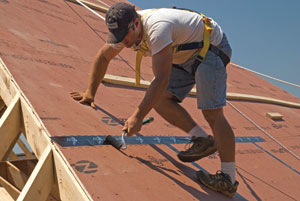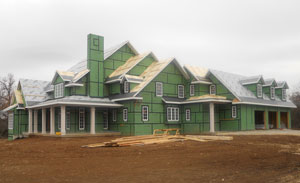High-Performance Wood-Framed Roofs
Roof Sheathing
Serving as a structural skin for the roof, roof sheathing supports the roof covering and transmits the load of this material as well as the live loads and loading due to snow, ice, and wind to the rafters or trusses or roof joists. Sheathing is secured to the supports and used as the base for fastening the roof coverings. In the early 20th century most roof sheathing was wood plank; today, it is typically either plywood or OSB.
Plywood. Constructed out of glued layers of orthogonally stacked wood veneers hot pressed together, plywood is a structural panel resistant to contraction and expansion. While lighter than OSB, when exposed to water plywood is susceptible to delaminating and weakening, which can cause the sheathing to lose strength and compromise the nailing. In a worst case scenario over a prolonged period of time, the roof covering will have to be removed, and the sheathing replaced.
OSB. In OSB, precisely cut wood strands are mixed with resin binders and oriented in a four-layer process in which two core layers are oriented perpendicular to two surface layers. The panel is then cured under intense heat and pressure to form an lasting bond between the strands. OSB sheathing is used extensively in residential and commercial construction as an alternative to PS-2 plywood. OSB panels are typically heavier and less absorbent than plywood, though OSB can be subject to edge swelling when exposed to moisture. However, high-performance OSB with greater water resistance is now commonplace. High-performance OSB are considered a high quality alternative to plywood and commodity OSB.
Underlayments
 |
|
Photo: Huber Engineered Woods Underlayments should be easy to install |
Initially used for temporary protection against the elements, underlayment is now an integral part of an overall roof system and adds a second layer of protection on top of the sheathing to keep out moisture. Underlayment is required by building codes to meet such standards in resisting fire, wind-driven rain, wind uplift, and punctures. Proper selection of underlayment depends on a variety of factors, including roof slope, fire code requirements, finished roofing material and climate considerations. An underlayment that performs well under a metal roof in the hot, humid South may not hold up in a cold Northeast climate under wooden shingles. There are typically four main categories of underlayments: felt, synthetics, self adhering ice and water barriers, and wood structural panels with a built-in moisture-resistive barrier.
Felt. Traditional black felt paper has been used in residential roof construction for half a century. Felt paper is either coated or saturated with asphalt to make it water-resistant, though not waterproof. Builder’s felt is available in 15 pound and 30 pound weights, which refers to the original weight of the papers, though modern production has made them actually lighter. Although considered a relatively easy to use and cost effective option, durability can be a problem. Felt paper can tear easily especially when wet. The 30 pound paper is thicker and stiffer, less prone to tearing, and provides more protection from water, but it is also much heavier and can be more difficult to work with. Architects should be aware that there are several ASTM standards that offer specifications for asphalt-saturated felt that many manufacturers fail to meet according to the International Association of Certified Home Inspectors —the papers are saturated to a lower level, predisposing these underlayments to absorb water and fail sooner.
Synthetic. A relative newcomer to the marketplace, synthetic underlayments offer greater resistance to water than felts. Made of synthetic polymers, the exact composition of which varies among manufacturers, synthetic underlayment is lightweight, UV resistant, safer to walk on, and resistant to insects, fungus and rot. More expensive than roofing felt, synthetics are also more resistant to tears and wrinkles, and lay down more evenly. Synthetics also come in light colors, enabling the roof to stay cooler, and are fabricated in larger sheets, which can save time during installation.
 |
|
Photo: Huber Engineered Woods Synthetic underlayments offer greater resistance to water than felts. |
Peel-n-Stick Materials. A square or rectangular roof underlayment with an adhesive backing that is peeled off and pressed into place, peel-n-stick materials are typically used in areas of the roof where ice dams or leaks are likely to occur. Considered a superior option for ice and water barriers, peel-n-stick underlayments can be a first layer on potentially problematic areas, or installed on the entire roof if it is low slope or flat. Water tends to pool up on these roofs, and the underlayment prevents it from seeping through. Thicker than other types of underlayment, peel-n-stick materials are noted for their durability to withstand the elements during roofing installation. One drawback is that the adhesive is temperature-sensitive until securely bonded to a dry surface with a temperature of more than 45 degrees Fahrenheit. Additionally, most of the materials are slippery, and unsafe to walk on directly after application.









